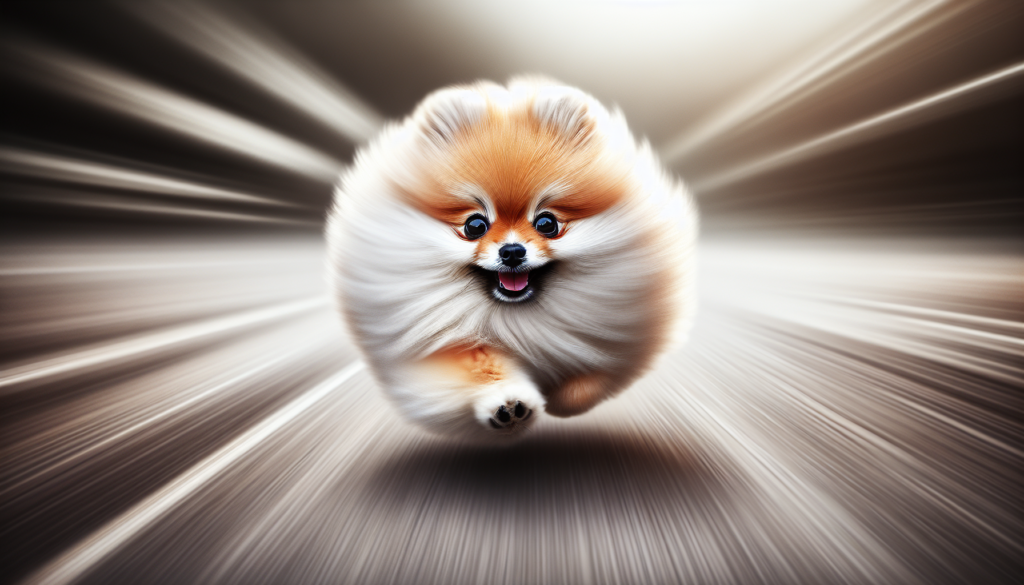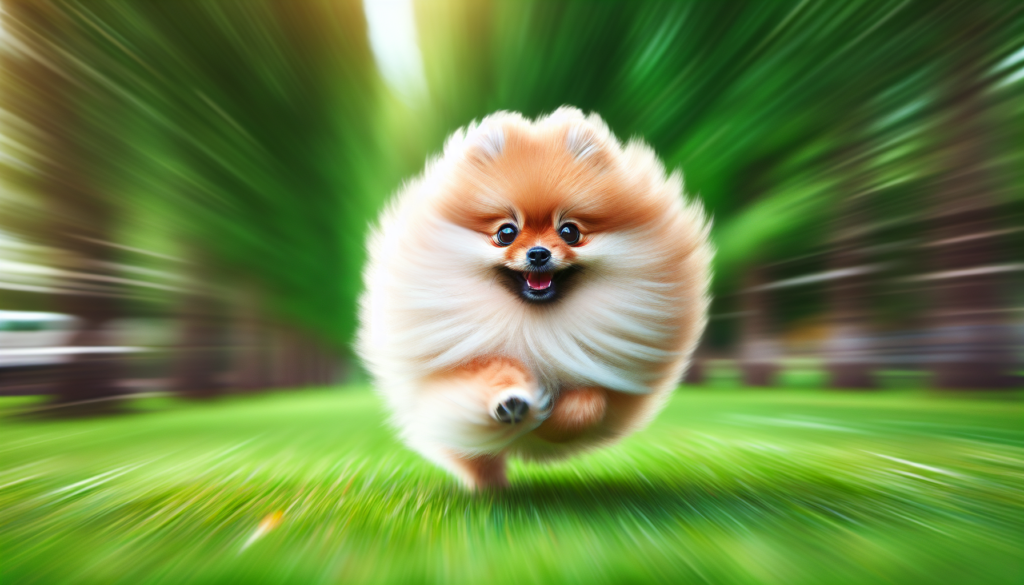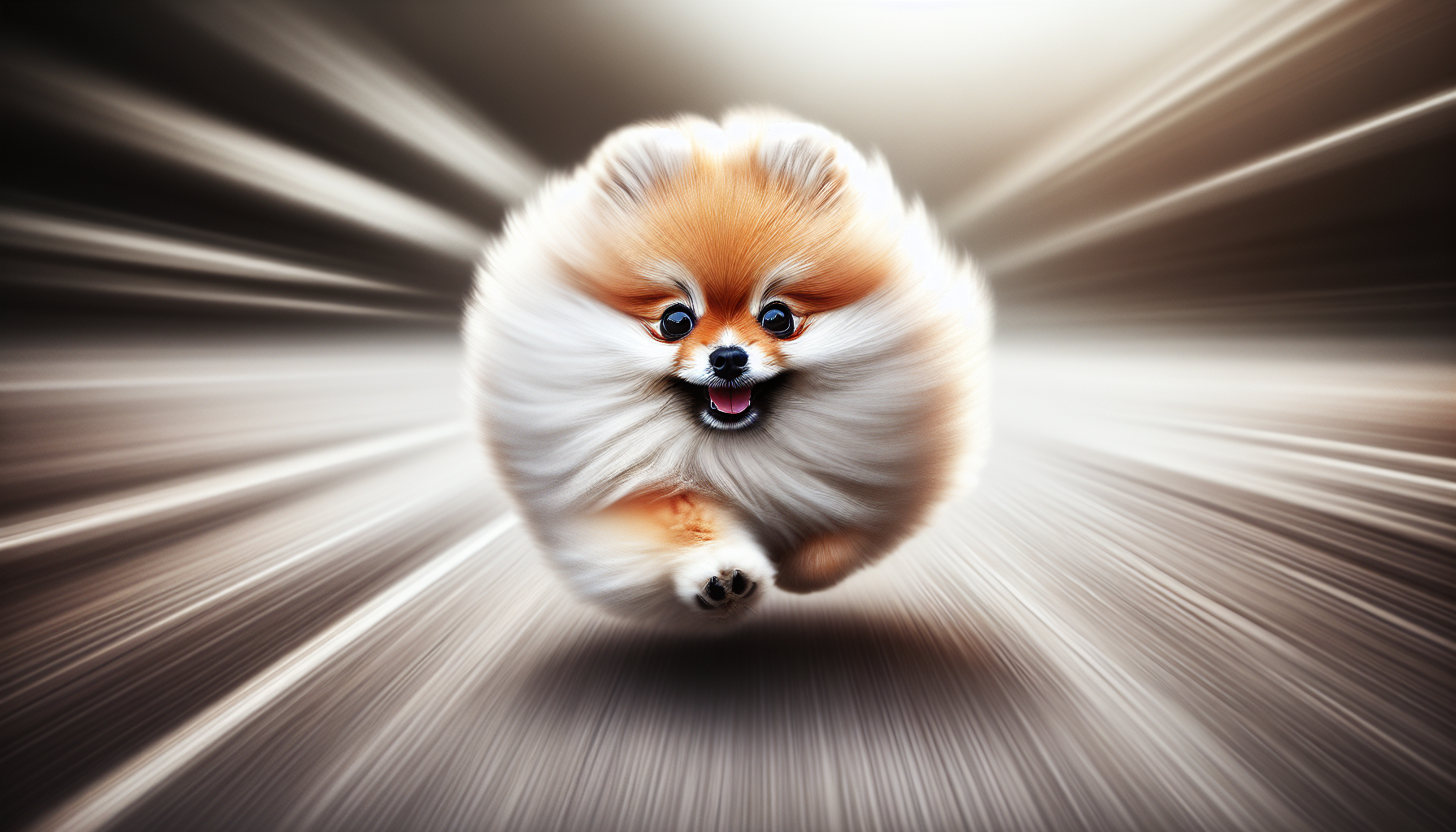Imagine you’re strolling through the park on a sunny day, and suddenly, you spot a miniature furball darting past you with lightning speed. Curiosity piques your interest as you wonder just how fast these tiny creatures can sprint. Well, brace yourself for some surprising information about the incredible speed of our beloved Pomeranian dogs. Despite their petite size, these fluffy companions possess an unexpected burst of energy that might leave you in awe. So, let’s embark on a delightful exploration of the Pomeranian’s agility and discover the remarkable speeds they can reach!
Physical Characteristics of Pomeranians
Size
Pomeranians are small-sized dogs, typically weighing between 3 and 7 pounds. They have compact bodies with a well-proportioned shape. Despite their small size, Pomeranians are sturdy and well-muscled dogs. They have a fox-like appearance, with a fluffy double coat and a plumed tail that curls over their back.
Coat
Pomeranians have a luxurious double coat that consists of a dense undercoat and a longer, harsh-textured outer coat. The coat comes in a variety of colors, including orange, black, white, cream, sable, and more. Regular brushing is necessary to keep their coat free of mats and tangles.
Weight
The weight of a Pomeranian can vary depending on factors such as genetics, diet, and exercise. On average, an adult Pomeranian will weigh around 4 to 7 pounds. It’s important to monitor their weight to ensure they stay within a healthy range, as obesity can lead to various health problems in this breed.
Body Structure
Pomeranians have a compact and well-balanced body structure. They have a short back, a deep chest, and straight front legs. Their hind legs are muscular, allowing them to have a strong and agile movement. Despite their small size, Pomeranians have a confident and alert posture, showcasing their lively and spirited nature.
Factors Affecting a Pomeranian’s Speed
Size
The size of a Pomeranian can influence its speed to some extent. Generally, smaller dogs have shorter strides and may not be able to cover as much ground as larger breeds. However, Pomeranians make up for their smaller size with their agility and nimbleness, enabling them to navigate rapidly through different terrains.
Health and Fitness
A Pomeranian’s overall health and fitness play a crucial role in its speed. Regular exercise, a balanced diet, and proper veterinary care contribute to maintaining a healthy weight and optimal muscle strength. Pomeranians that are in good health and fitness tend to have better endurance and speed compared to those with underlying health issues.
Age
As dogs age, their speed and physical abilities may naturally decrease. Pomeranians are known for their longevity, often living well into their teens. However, as they age, their speed may decline gradually. It’s important to adjust their exercise routines and provide appropriate care to accommodate their changing needs as they grow older.
Temperament
A Pomeranian’s temperament can affect its speed during physical activities. Pomeranians are typically energetic and enthusiastic dogs. Their high spirits and playfulness can contribute to their speed and agility. A well-socialized and confident Pomeranian is more likely to enjoy physical activities and exhibit greater speed while running or engaging in other exercises.
Training
The level of training a Pomeranian receives can significantly impact its speed and performance. Regular training sessions focused on building endurance, speed, and obedience can help improve a Pomeranian’s athletic abilities. Consistent and positive reinforcement-based training methods can enhance their speed and responsiveness to commands.

Average Running Speed of Pomeranians
Different Pacing
Pomeranians have a unique running style and may have different pacing compared to other dog breeds. Their short legs and compact bodies contribute to a bouncy and quick gait. On average, a Pomeranian can reach speeds of around 12 to 16 miles per hour during a full sprint. However, their speed may vary depending on individual factors.
Pomeranians vs. Other Breeds
When compared to larger dog breeds, Pomeranians may not be considered the fastest runners. However, their speed is impressive for their size. It’s important to note that Pomeranians excel in agility and quick bursts of speed rather than endurance running. They are more suitable for short bursts of energy rather than long-distance running.
Variations Among Individuals
It’s essential to remember that individual Pomeranians may have varying running speeds. Factors such as genetics, health, training, and natural ability can contribute to these differences. Some Pomeranians may be naturally faster, while others may require more training and conditioning to improve their speed.
Determining Factors in a Pomeranian’s Speed
Stride Length
The length of a Pomeranian’s stride will directly impact its speed. Generally, shorter legs may result in shorter strides. However, Pomeranians compensate with their quick movements and agile nature. Their energetic top line and well-developed muscles enable them to cover ground efficiently despite their small stature.
Leg Length
Pomeranians have relatively short legs compared to larger dog breeds. While shorter legs may limit their stride length, Pomeranians exhibit remarkable agility and quickness. Their hind legs provide the necessary power to propel them forward, allowing them to reach impressive speeds despite their small size.
Muscle Strength
A Pomeranian’s muscle strength is vital for maintaining speed and endurance. Owners can assist in building muscle strength through regular exercise routines that include activities such as running, jumping, and playing fetch. Strong muscles contribute to better speed, agility, and overall athletic performance.
Fitness Level
A Pomeranian’s fitness level is directly linked to its ability to maintain speed and endurance. Regular exercise and a balanced diet are necessary to maintain optimal fitness. Incorporating cardiovascular activities, such as brisk walking or running, alongside strength-building exercises can help improve a Pomeranian’s speed over time.
Conditioning
Conditioning plays a crucial role in enhancing a Pomeranian’s speed and overall athletic abilities. Gradual and progressive training can help improve their endurance, allowing them to sustain their speed for longer periods. It’s important to consult with a veterinarian or professional dog trainer to develop an appropriate conditioning program for your Pomeranian.

Training a Pomeranian for Speed
Basic Obedience Training
Training a Pomeranian for speed should begin with basic obedience training. Teaching commands such as “sit,” “stay,” and “come” will not only promote safety but also establish a foundation for more advanced training. Positive reinforcement methods, such as treats and praises, should be utilized to create a positive learning environment.
Building Endurance
Endurance training is essential to improve a Pomeranian’s speed and stamina. Gradually increasing the duration and intensity of exercise sessions will help build endurance over time. Incorporating activities such as longer walks, jogging, and hiking can help improve cardiovascular health and endurance levels.
Interval Training
Interval training involves alternating between high-intensity bursts of exercise and periods of rest or lower intensity. This type of training can be beneficial in improving a Pomeranian’s speed. Incorporate short sprints or fast-paced games during play sessions to simulate interval training. Be sure to provide adequate rest periods between these bursts of activity.
Proper Warm-up and Cool-down
Before engaging in any high-intensity exercise or speed training, it is crucial to warm up your Pomeranian’s muscles and joints. This can be achieved through gentle stretching and a short walk. Similarly, a cool-down period after intense exercise is essential to gradually decrease heart rate and prevent muscle soreness.
Nutrition and Hydration
Proper nutrition and hydration are fundamental for a Pomeranian’s overall health and athletic performance. Consult with a veterinarian to determine an appropriate diet based on your Pomeranian’s age, weight, and activity level. Always ensure fresh water is available during and after exercise to prevent dehydration.
Health Considerations and Running Limits
Orthopedic Issues
Pomeranians, like many small dog breeds, may be prone to certain orthopedic issues such as luxating patella (dislocation of the kneecap) and hip dysplasia. These conditions can affect a Pomeranian’s running ability and should be monitored closely. Regular veterinary check-ups and following recommended preventive measures can help minimize the risk of orthopedic problems.
Heart and Respiratory Health
Due to their small size, Pomeranians may be susceptible to certain heart and respiratory conditions. It is important to monitor their breathing during exercise and limit intense activities if they show signs of respiratory distress. Regular veterinary check-ups and prompt treatment of any heart or respiratory issues are essential for maintaining their overall health.
Heat Sensitivity
Pomeranians have a dense double coat, making them more sensitive to heat. They may struggle to regulate their body temperature efficiently, especially in hot and humid climates. It is crucial to avoid exercising them during the hottest parts of the day and provide ample shade and water during outdoor activities. Signs of overheating, such as excessive panting or lethargy, should be taken seriously.
Overexertion
While Pomeranians have bursts of energy and can reach impressive speeds, it’s important not to overexert them. Pushing them beyond their limits or engaging in excessive high-impact activities can lead to fatigue, injuries, and potential health issues. Pay attention to their energy levels, and provide appropriate rest and recovery periods.
Common Injuries
Pomeranians can be prone to certain injuries common in small dog breeds, such as patellar luxation, ligament sprains, and fractures. It’s crucial to provide a safe and secure environment during exercise and supervise their activities to prevent accidents. Regular veterinary check-ups and prompt treatment of any injuries are essential for their well-being.
Ideal Exercise and Physical Activity for Pomeranians
Daily Walks
Daily walks are essential for a Pomeranian’s physical and mental well-being. Aim for at least two short walks per day, ensuring they have the opportunity to explore their surroundings and get some exercise. Walking not only helps maintain their physical health but also provides mental stimulation through exposure to different sights, sounds, and smells.
Play Sessions
Engaging in play sessions is a great way to provide exercise and mental stimulation for Pomeranians. Incorporate games such as fetch or hide-and-seek to keep them active and entertained. Supervised play with other dogs can also provide socialization opportunities, contributing to their overall well-being.
Agility Training
Agility training is an excellent way to improve a Pomeranian’s speed, agility, and overall athleticism. Set up agility courses or participate in classes specifically designed for small dog breeds. This type of training not only provides physical exercise but also stimulates their minds by challenging them to navigate obstacles and follow commands.
Mental Stimulation
Mental stimulation is just as crucial as physical exercise for a Pomeranian’s well-being. Engage them in activities such as puzzle toys, obedience training, and interactive games to keep their minds active and prevent boredom. Mental stimulation helps maintain their cognitive abilities and can also contribute to a well-behaved and responsive dog.
Weight Management
Maintaining a healthy weight is vital for a Pomeranian’s overall health and longevity. Obesity can lead to various health issues and limit their speed and agility. Consult with a veterinarian to determine the appropriate amount of food and portion sizes for your Pomeranian, and regularly monitor their weight to make necessary adjustments to their diet and exercise routine.
Comparing Pomeranians to Other Small Dog Breeds
Dachshunds
Dachshunds, also known as “wiener dogs,” have a unique body structure with a long, elongated back and short legs. While they may not be as fast as Pomeranians, their long bodies enable them to excel in activities such as digging and hunting. Dachshunds have a moderate running speed and are known for their endurance rather than quick bursts of speed.
Chihuahuas
Chihuahuas are one of the smallest dog breeds, often weighing less than 6 pounds. They have a lively and energetic nature, similar to Pomeranians. While their tiny size may limit their speed, Chihuahuas can be surprisingly fast and agile. Their high energy levels make them suitable for various physical activities, including running and playing.
French Bulldogs
French Bulldogs are compact dogs with a muscular build. While they may not be as fast as Pomeranians, they make up for it with their playful and affectionate nature. French Bulldogs have moderate running speeds and can enjoy short bursts of speed during play. They require regular exercise to maintain a healthy weight and overall well-being.
Pugs
Pugs are known for their adorable squished faces and compact bodies. They are not the fastest runners due to their short legs and brachycephalic (short-nosed) facial structure, which can affect their breathing. Pugs excel in low-impact exercises such as walking and light play sessions. Moderate running speeds can be achieved, but they are not built for prolonged high-intensity activities.
Shih Tzus
Shih Tzus are small-sized dogs with a long, flowing coat and a friendly disposition. While they may not have impressive running speeds, they are agile and excel in activities such as agility training and obedience. Short bursts of speed can be observed during play sessions, but their focus is more on mental stimulation and companionship.
Promoting a Healthy and Active Lifestyle for Pomeranians
Regular Veterinary Check-ups
Regular veterinary check-ups are crucial for maintaining a Pomeranian’s overall health and well-being. Schedule routine examinations to monitor their weight, heart health, and address any potential issues promptly. Vaccinations, parasite prevention, and dental care should also be discussed with your veterinarian to ensure your Pomeranian stays healthy.
Balanced Diet
A balanced diet is essential for a Pomeranian’s health, energy levels, and overall athletic performance. Consult with a veterinarian to determine the appropriate type and amount of food for your Pomeranian based on factors such as age, weight, and activity level. High-quality, nutrient-rich food will provide the necessary fuel for their physical activities.
Grooming
Regular grooming is necessary to keep a Pomeranian’s coat healthy and free of tangles or mats. Brush their coat daily to prevent the buildup of dead hair and maintain its natural shine. Bathing should be done as needed, using a dog-specific shampoo. Pay attention to their dental hygiene as well, brushing their teeth regularly to prevent dental issues.
Socialization
Socialization is a crucial aspect of a Pomeranian’s overall well-being. Expose them to various environments, sounds, and people from an early age to help them become confident and well-adjusted dogs. Socialization also provides opportunities for mental stimulation, which can contribute to their happiness and reduce the risk of behavioral issues.
Physical and Mental Enrichment
Engaging a Pomeranian in physical and mental enrichment activities is vital for their overall health and happiness. Provide them with interactive toys, puzzle games, and obedience training sessions to challenge their minds. Rotate their toys regularly to prevent boredom, and create a stimulating environment that promotes an active and curious lifestyle.
Conclusion
Pomeranians may be small in size, but they possess remarkable speed, agility, and a zest for life. While individual running speeds may vary, their high energy levels and lively personalities make them suitable for various physical activities. By providing proper training, nutrition, and care, you can help your Pomeranian achieve their full athletic potential and enjoy a healthy and active lifestyle. Remember to consider their individual needs and consult with a veterinarian for personalized advice to keep your Pomeranian happy and thriving.
